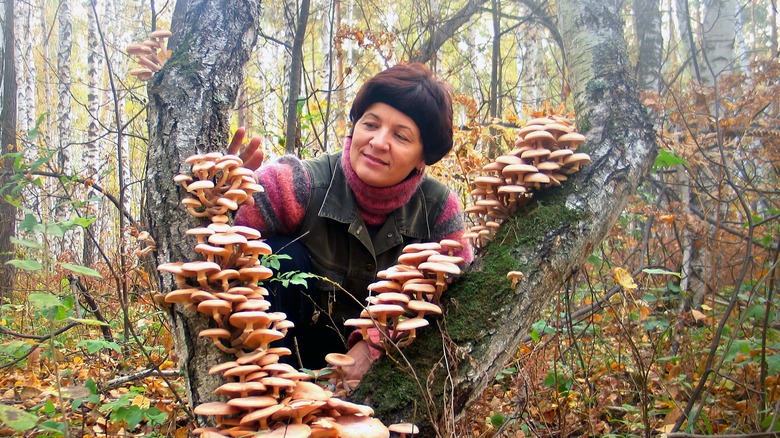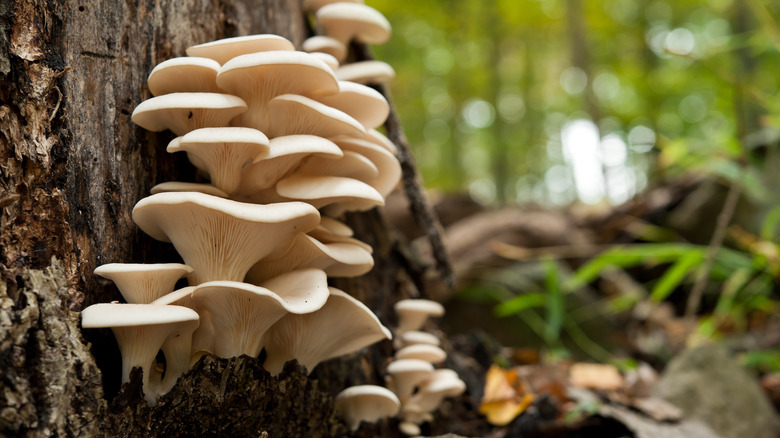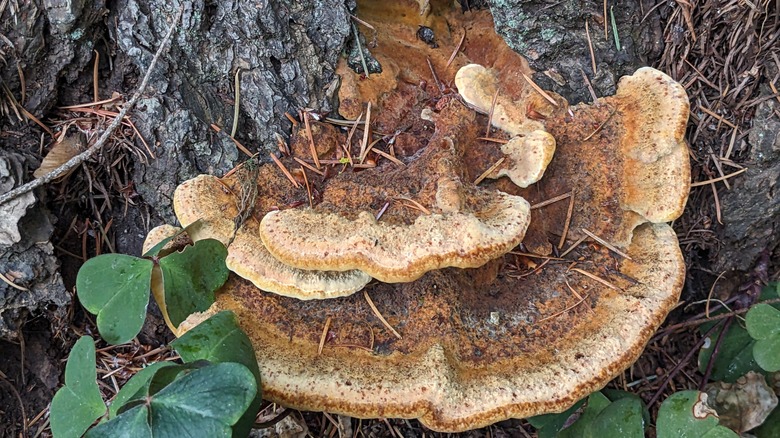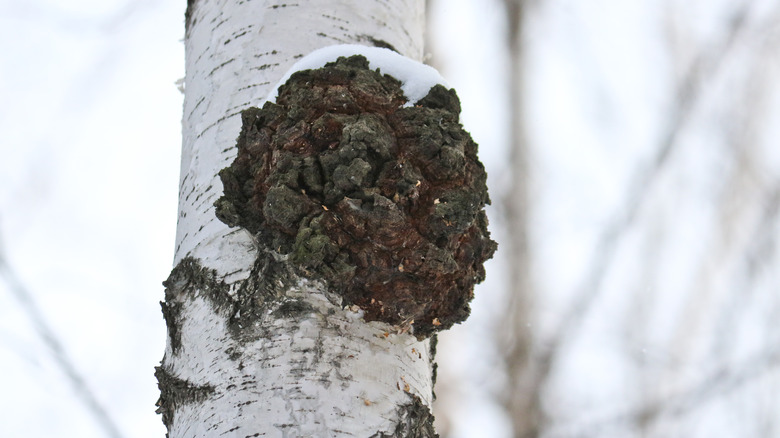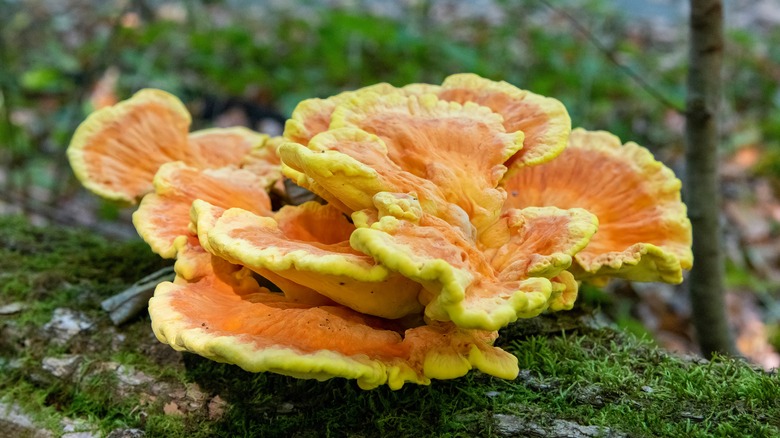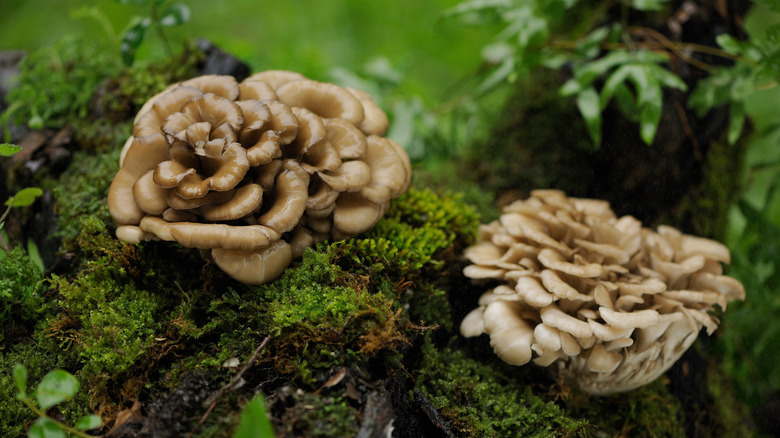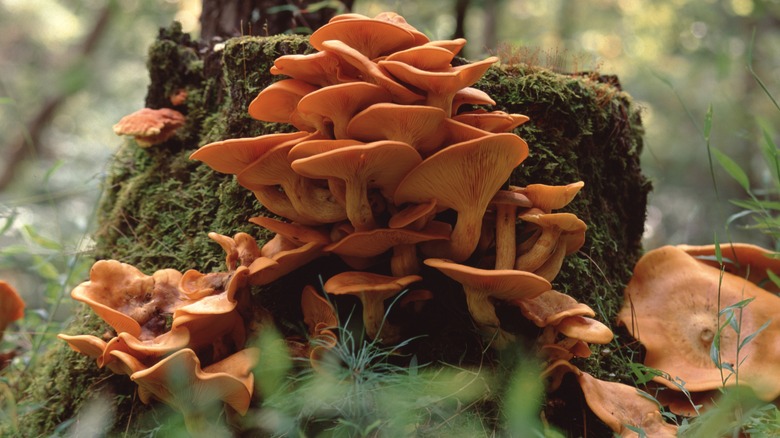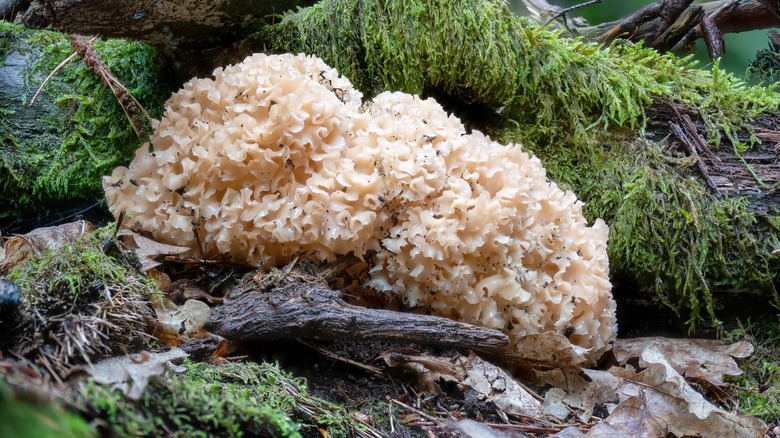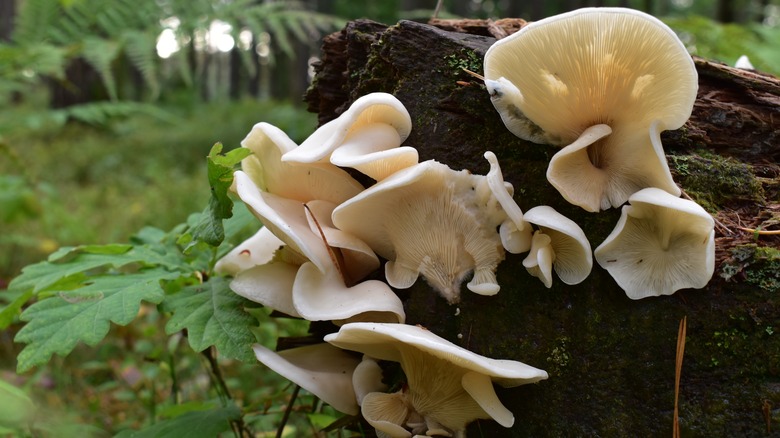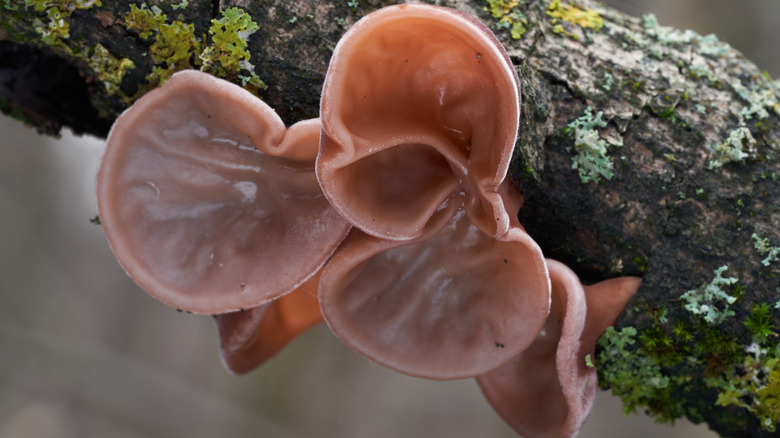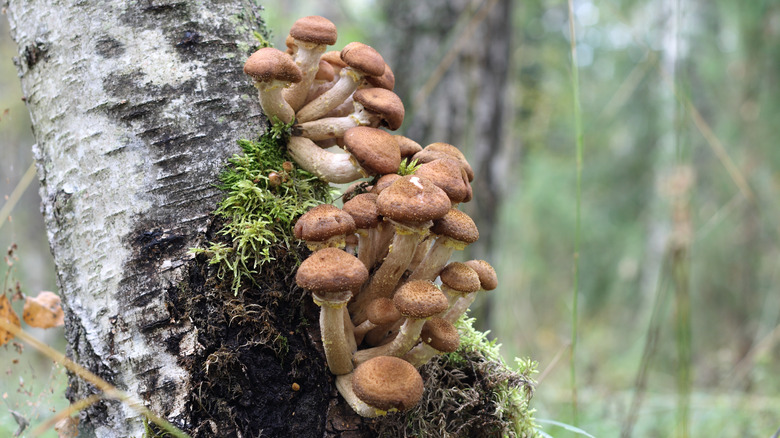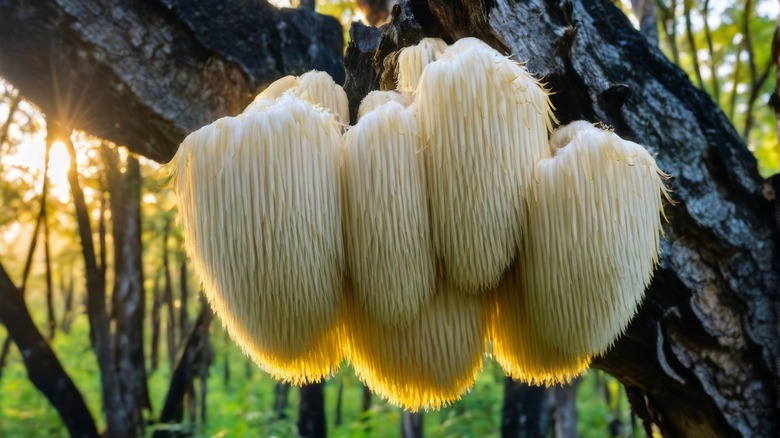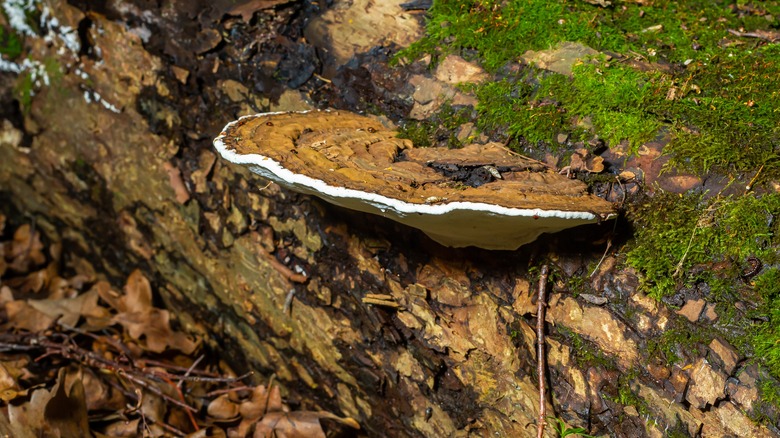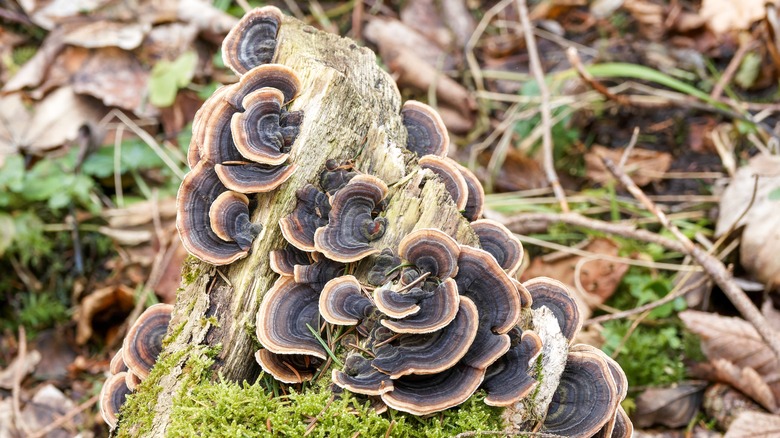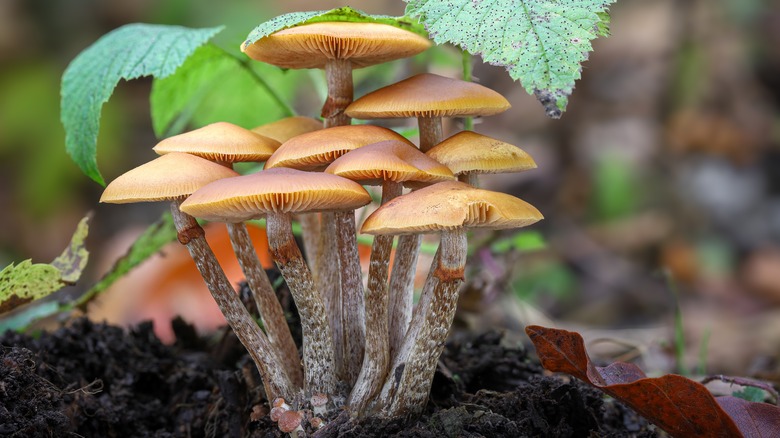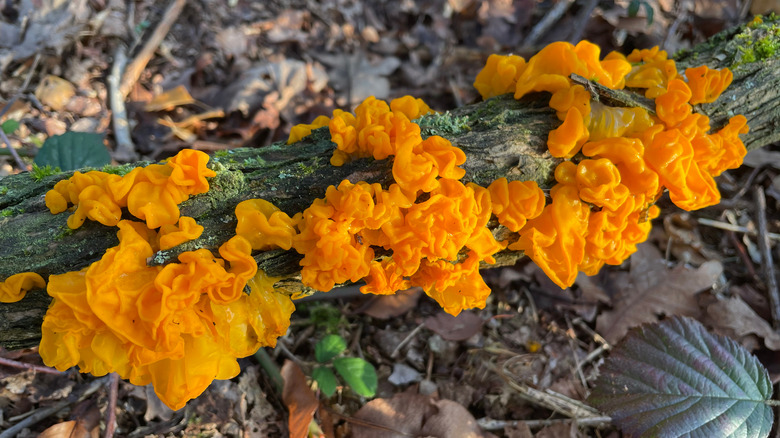15 Common Mushrooms That Grow On Trees In Your Yard
Fungi and trees have shared a close-knit relationship for millions of years thanks to mycelium, which forms networks around trees' roots, communicating and transferring nutrients between them. Many fungi will also jump at the opportunity to feed on a sick or dying tree, and some will even act as parasites on living trees, creeping into wounds and digesting healthy plant matter. Although the process is slow, this can be concerning if you have a tree near your home, as a rotten tree base can make it more likely to fall. If you notice mushrooms on your tree, there's not much you can do except be aware of the type of mushrooms growing on your trees and how they may be affecting them. Some general types of mushrooms that grow on trees include bracket or 'shelf' mushrooms, jelly fungus, and cap fungus, although the wild world of mushrooms rarely fits into these neat categories.
Remember that mushroom identification is notoriously difficult, so it's best not to touch any mushroom unless you are 100% certain of its species. Besides, mushrooms are just the fruiting body, so knocking off visible mushrooms won't do much to help your tree. Here are 15 of the most common fungi you'll find growing on the trees in your yard, what it really means when mushrooms start growing on your trees, and which mushrooms may present a danger to you, your family and pets, or the trees themselves.
1. Oyster mushrooms
Oyster mushrooms are a broad category of mushrooms mainly consisting of those in the Pluerotus species. Oyster mushrooms are one of the most common fungi growing on trees throughout the world, especially in deciduous forests with oak and beech trees. These mushrooms can vary in appearance, but most grow in clumps with brownish caps and pale gills extending all the way down the stem. All true oyster mushrooms are edible and won't present a major threat to tree health. Plus, they kill and eat roundworms, making them technically carnivorous.
2. Dyer's polypore
Polypores, overall, are common mushrooms found growing on trees, but dyer's polypore (Phaeolus schweinitzii) is among the most iconic, so named for its use as a bright yellow dye. This shelf mushroom prefers to grow on coniferous trees like pine, spruce, douglas fir, and western hemlock. It can vary greatly in color, from black to dark brown and bright orange, but it usually has a velvety look with a pale lip around the edge of each shelf. Be aware that dyer's polypore is saprobic and parasitic, eating away at the tree, causing brown rot, and potentially killing it.
3. Chaga
One of the uglier mushrooms to find on trees, Chaga fungus (Inonotus obliquus), looks like a dark, crusty, rough bump jutting out from the side of the tree trunk. It tends to grow on birch, ash, elm, and beech trees. In general, a tree has to be damaged in some way for chaga to take hold. Once infected, the fungus can live in the tree for 80 years or more. Luckily, Chaga is relatively harmless to trees, only sprouting its fruiting body when the tree dies of some other natural cause. Chaga is also highly coveted for its nutrition and health benefits!
4. Chicken of the woods
With velvety shelfs of bright orange and yellow, this well-known mushroom looks a bit like a piece of fried chicken sticking out from the tree. There are several species in the Laetiporus genus referred to as 'chicken of the woods,' also known as 'chicken fungus' or 'sulfur shelf.' These edible mushrooms are a favorite among foragers for their chicken-like texture. This mushroom mostly grows on trees and stumps that are already dead and decaying, and it has a preference for hardwoods like oak, cherry, maple, and beech.
5. Hen of the woods
Not to be confused with Chicken of the Woods, Hen of the Woods is also known as 'maitake' (Grifola frondosa). This pale brown mushroom commonly grows on the base and roots of oaks but may select other hardwood trees. Very popular in Japanese cuisine, maitake is one of the edible mushroom varieties you can grow at home. However, it isn't one you'll want to find on your backyard trees. This fungus is parasitic and may cause trees to develop a condition known as butt rot, which can eventually weaken the tree and cause it to fall.
6. Jack o' lantern
The Jack o' lantern mushroom (Omphalotus olearius) is often found at the base of hardwood trees and is identified by its bright orange caps and long, frilly gills. Some people may confuse Jack o' lantern for tasty chanterelles, but don't be tempted by its welcoming orange glow. This is one of the deadly mushroom types that could be growing in your backyard. Jack o' lantern mushrooms feed on decaying wood and roots, so while it may indicate that a tree is dying, it won't speed up the process or harm the living tree.
7. Cauliflower fungus
If you stumble upon this mushroom in the woods, you might mistake it for cauliflower from a distance. Sparassis is a genus of mushrooms that grow in tight, frilly clumps, with a color that can vary from bright white to caramel and dark brown — much like a roasted cauliflower. Cauliflower fungus is non-toxic and even edible for humans, but it is parasitic to trees, especially around the base of conifers. This mushroom will eat away at living and dead plant matter, causing problems like brown rot.
8. Angel wings
Angel wings (Pleurocybella porrigens) can be easily recognized by its fan-shaped shelves and stunning bright white color. This mushroom grows on coniferous trees and dead wood, like stumps and fallen logs. Although it has a thinner cap and shorter stem, Angel wings is sometimes confused with oyster mushrooms. This mushroom is controversial, with some claiming it's toxic and others saying it's safe — so it's best to steer clear, just in case. Since it is saprotrophic, angel wings doesn't present a problem for living trees, but it can indicate decaying wood.
9. Wood ear
Wood ear mushrooms (Auricularia auricula-judae) are some of the most bizarre mushrooms you might find growing on trees in your yard. Like the name implies, these fruiting bodies literally look like little waxy, folding ears sprouting out of the wood. Wood ear usually grows on decaying wood, such as fallen limbs and stumps, and it prefers mostly softwood trees like spruce, pine, and fir, but it will also grow on oak and poplar. Wood ear is mostly saprotrophic but sometimes digests living plant matter and may indicate that a tree is sick and decaying.
10. Honey mushroom
Honey mushrooms belong to the genus Armillaria. Varying wildly in color and appearance, most grow in tight bunches and have a pale brown or yellowish color with speckled, textured caps. Honey mushrooms themselves may not be toxic, but they have some very poisonous lookalikes, so it's best to avoid them. While their name might sound sweet, honey mushrooms are some of the worst fungi to spot in your yard, as they're parasitic, pathogenic, and can cause white rot. They also don't have a strict tree preference, spreading quickly between hardwood and conifer trees.
11. Lion's mane
Lion's mane (Hericium erinaceus) is one of the most iconic mushrooms that grow on trees, easily recognizable by their bright white color and shaggy, mane-like appearance. Lion's mane mushrooms can grow quite large and are praised for their health benefits. Still, they may not be a good sign for trees. This mushroom is both saprotrophic and parasitic, meaning it will feed on both dead and living trees and potentially cause damage. Lion's mane usually targets injured hardwood trees like oaks, elms, beech, maple, and sycamore.
12. Artist's conk
Another eye-catching polypore fungus, artist's conk (Ganoderma applanatum), boasts shades of pale brown, tan, and white that form rings on the top of the shelf. Underneath, each mushroom has a smooth white surface that bruises easily, making it an ideal surface for etching words and drawings. Artist's conk is considered inedible and typically grows on hardwood trees like oak, maple, beech, and birch. While it mostly sticks to decaying logs, stumps, and branches, this fungus is also parasitic and will grow in the wounds of living trees.
13. Turkey tail
Sometimes, turkey tail (Trametes versicolor) can look a bit like artist's conk or other polypores, but it has a much thinner, flatter appearance overall — think a potato chip versus a slice of bread. This edible mushroom grows in groups on deciduous trees, such as oaks, ash, and birch. Turkey tail is saprotrophic, so it mostly digests already dead wood. Because of this, you don't need to worry about the mushroom damaging your live trees, but spotting it on a live tree can tell you that the tree is already sick or weakened.
14. Funeral bell
Galerina marginata goes by a few different names, including the 'funeral bell,' 'autumn skullcap,' or 'deadly galerina.' As these names imply, this isn't an edible mushroom; funeral bell contains the same toxins as the infamous death cap mushroom. These mushrooms have smooth, sticky, and somewhat flat caps with a dark honey-brown color and a ring around the stalk. They usually grow in loose groups on decaying wood and logs, both deciduous and coniferous. While you won't want them anywhere near your family or pets, funeral bells are saprotrophic, so they won't parasitize healthy trees.
15. Witch's butter
One of the brightest mushrooms on this list, witch's butter (Tremella mesenterica), is a vibrant yellow-orange jelly fungus that forms in wrinkly folds. It's also a favorite delicacy among wild mushroom foragers who treasure it for its fun, gummy bear-like texture. This fascinating fungus grows year-round on dead and decaying wood, especially deciduous trees and hardwoods like oak, birch, beech, and maple. Witch's butter is one of the few mushrooms that doesn't actually feed on the wood itself but rather on other parasitizing fungi and doesn't present any threat to living trees.
